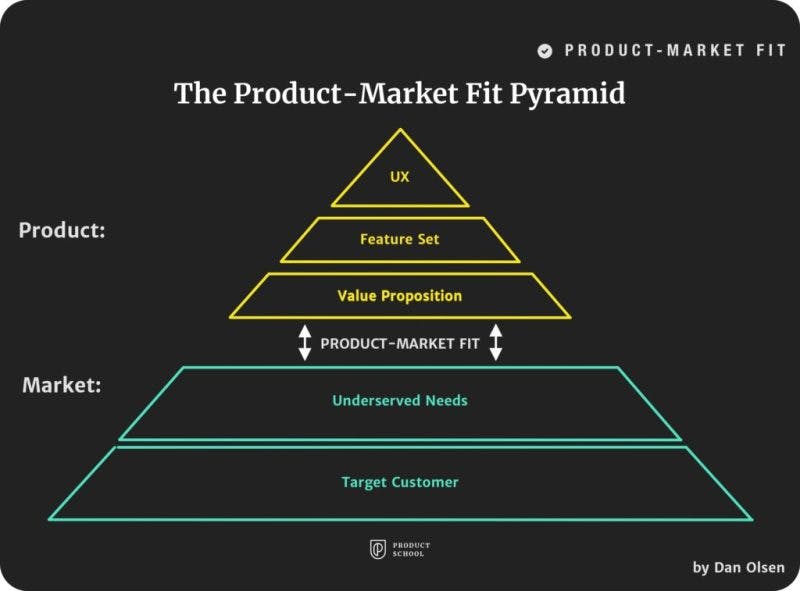Updated: January 24, 2024- 9 min read
So you’ve put together an incredible team, you’ve built the world’s best product, and you’re ready to send it out into the world and get it to the people. But how exactly are you going to achieve that? Will you launch it in the app store and on your website and just…pray? Hopefully, you’ve got more of a plan than that, and that plan is your Go To Market strategy.
What Is a Go To Market Strategy?

A Go To Market (GTM) strategy is essentially your marketing plan for making sure your target market knows about your launch – be it for a feature or for a whole new product. A GTM strategy applies whether you’re breaking into a new market, or trying to reach your current market.
It’s a document that outlines your pricing structure, aspects of your target market, your value proposition, and your distribution plan.
Similar to a roadmap, this document must be agile in order to adapt to any changes.
If you don’t come from a marketing background, it could sound complicated and like a lot of work. You might also be asking yourself "I’m a Product Manager…do I need to be involved in this? Isn’t this a thing for the marketing team?".
If you’ve ever heard the story of Jack and the Beanstalk, you know that it’s not a good idea to let someone else take your cow to market, or they’ll sell it for some beans! It’s not that you don’t trust your marketing team, it’s more that you have the knowledge they need to successfully bring your product to market.
A great GTM strategy relies on user/buyer personas, market understanding, and an understanding of the long-term business plan. That’s why it’s critical for Product Managers to work in collaboration with marketing on a GTM strategy.
If you give marketing a chance, you might even find it fun!
Real Go To Market Strategies: Apple Watch

It’s sometimes hard to describe documents and methodologies without sounding vague, especially in product since they’re mostly agile and can vary from company to company (or even from product to product within the same company). So it’s more helpful to look at some real-world examples, to see how great Go To Market Strategies can launch a product towards huge success.
So let’s take a quick look at how Apple uses marketing strategies to bring the Apple Watch to market.
When the Apple Watch was first launched, Apple already had a built-in customer base – but that doesn’t guarantee an automatic win. Plenty of tech giants have experienced catastrophic failures in the past.
You might also be interested in: Design Thinking for PMs: 3 Lessons from Apple and Google
The way Apple Watch succeeded was by hyper-focusing on luxury-oriented customers. Smartwatches were nowhere near as commonplace as they are today, and rather than try to convince every single customer that they needed the Apple Watch, the company decided to focus on a smaller portion of their customers.
They did this by building collaborations with luxury brands like Tesla and Hermes, and by advertising in places where tech typically isn’t found – like fashion magazines.
They didn’t need to spend money advertising in tech magazines, because of course tech nerds everywhere would know about the new offering.
By thinking creatively, and utilizing a fresh use case and buyer persona, they were able to capitalize on a corner of the market that they otherwise would have left relatively untouched.
None of this was accidental, this was planned out and all part of their GTM strategy.
Laying the Groundwork: What to Prepare Before Building Your Strategy
You’ll need to have a clear idea of your product-market fit, which is actually something that you should have secured before you even started building your product. If you’re only just getting to it pre-launch…you might find some serious speedbumps.
Check out what happens to products that never found their product-market fit.

While you should already have this nailed, let’s do a quick refresher. Dan Olsen’s Product-Market Fit Pyramid shows the steps needed to be taken to achieve it:
Before you do anything else, you need to have found your target customer. That customer needs to have a need that is underserved (aka, there aren’t already dozens of well-adopted products that serve that need), and your product needs to be able to fit into that gap in the market.
This also involves having a good understanding of your market landscape. Who else is currently in the space? Who is poised to dominate? What can you offer your customers that your competitors can’t?
This will help you to create your business case. It’s not enough to want to sell your product to customers, you have to be able to articulate why.
Steps to Creating Your Go To Market Strategy
There’s more than one way to go about building a GTM strategy, and a lot of it will depend on your company, product, industry, budget, resources…there’s a lot that goes into it!
So keep that in mind when you start building your strategy. If the situation changes, your strategy needs to be flexible enough to adapt. With that in mind, we’ve created a basic template that should guide you towards building a winning strategy.

Just keep in mind these tips:
Tip 1: Work collaboratively with marketing, sales, and leadership to craft the perfect GTM strategy.
Tip 2: Go back to your plan before launch to see if anything can be improved or if any potential pain points can be fixed.
Step 1: Identify your Launch Owner
This is the person who will be the main point of contact for the product launch. They’ll take the lead on building the GTM action plan and making sure it is communicated across the entire team.
Sometimes this person is the Product Manager, but that may not be the case if they’re too busy getting the product itself ready for launch. It may also be the Product Marketing Manager, who will often liaise with the Product Manager.
The launch owner will also be in charge of creating a Launch Tracker. This is an important document which tracks potential pain points, who raised them, and whether or not they were resolved. It also tracks which important decisions were made by who, and when.
Step 2: Know who you’re trying to reach
Somewhere during product development, you identified your target audience and potential customers. You may have done this by building user personas (or your UX designer built your user personas).
To see more about user personas, check out our guide plus some templates to get you inspired.
Part of this is also knowing what the competition is like. How many people in your target market are probably already using your competitor’s product?
At this point you should also be thinking about your use cases. You know who you’re users are, but you need to be able to demonstrate how they’ll use your product, and how it’s going to benefit them in the long run.
Step 3: Determine your pricing and sales strategies
This step will be much simpler if you’re releasing a new feature or a rebrand for an existing product, but what happens if you’re launching something brand new? You need to figure out how to monetize it. This will go hand in hand with your sales strategy, so be sure to work closely with your sales teams on that. If you work in a larger company there likely will already be plans and protocols in place.
Step 4: Build your marketing strategy

This is easier for existing products and services, because you hopefully already have a platform and or/a community. Your marketing team will know some very specific things like, ‘what’s the average price per click on our ad campaigns?’ or ‘how many email subscribers do we have, and in which segments?’ If you’re launching something new, you have to start from scratch.
If you don’t come from a marketing background, then this is a great learning opportunity. You’ll be working very closely with your Product Marketing Manager, who should already have some great ideas for ad, email, and content marketing campaigns.
Wondering how to get started? Check out our guide to product marketing.
Step 5: Identify your metrics
This is all part of being a data-driven Product Manager. You need to know if your campaigns are working, and if they’re cost-effective. You don’t want your customers to cost more money to acquire than they’re going to spend on your product. We call this metric your Customer Acquisition Cost (CAC). This number will frequently change, as it’s calculated by adding the total expense of your marketing and customer support strategies, and dividing it by the number of customers acquired.
(It’s helpful to do this within a specific time period of time, and use them to track your progress. When you see that your CAC is going up, it’s time to rethink your marketing strategies.)
Step 6: Make a plan for customer support
New tech adoption is a pretty hot topic, alongside discoverability. While you want people to easily discover your new feature or take to your new product, you have to be prepared for those customers who will struggle.
Great customer support can make or break a product, so make a plan and have it factored into your CAC calculations.
Step 7: Consolidate your post-launch resources
Ask yourself what you’re going to need once the product has launched. Will you need the same level of customer support, and will you want to maintain the same marketing campaigns?
Part of getting your product to market is to understand how you’re going to keep it there. If you burn through all of your marketing resources at launch, how are you planning on reaching new customers? A GTM strategy is as much a long-term plan as it is a pre-launch blueprint.
Ready to Learn More?
If you enjoyed that, and you’re looking forward to building a great GTM strategy, you can learn all that and more with our Product Manager Certifications.
Updated: January 24, 2024





